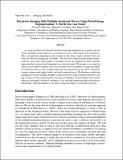Recursive Imaging with Multiply-Scattered Waves Using Partial Image Regularization: A North Sea Case Study
Author(s)
Malcolm, Alison E.; de Hoop, Maarten V.; Ursin, Bjorn
Downloadpaper10_malcolm_recursiveimag_2010.pdf (2.743Mb)
Other Contributors
Massachusetts Institute of Technology. Earth Resources Laboratory
Metadata
Show full item recordAbstract
As more resources are directed toward reverse-time migration an accurate velocity
model, including strong reflectors, is necessary to form a clear image of the subsurface.
This is of particular importance in the vicinity of salt, where singly-scattered waves are
often not ideal for imaging the salt flanks. This has led to interest in processing doubly-scattered
waves (also called duplex or prismatic waves) for imaging salt flanks and thus
improving the location of salt boundaries in a velocity model. We present a case study in
which we use doubly-scattered waves in a two-pass one-way method to image salt flanks
in a North Sea data set. By working in the one-way framework we are able to separately
construct images with singly, doubly, and triply scattered waves. We illustrate a multi-step
imaging process that includes multiply-scattered waves by using an imaged reflector to fix
one (or more) of the scattering points, allowing for multiply-scattered energy from several
reflectors, potentially with poor continuity, to be included without picking each reflector
individually. With this method we are able to image the flank of a North Sea salt body.
Date issued
2010Publisher
Massachusetts Institute of Technology. Earth Resources Laboratory
Series/Report no.
Earth Resources Laboratory Industry Consortia Annual Report;2010-10
Keywords
Imaging, Multiples